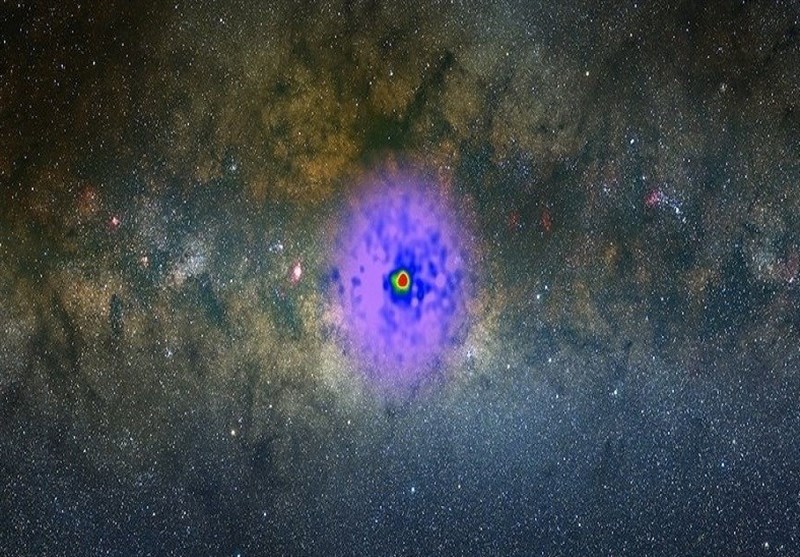Mysterious Glow Caught in Our Galaxy's Center Really Could Be Due to Dark Matter
TEHRAN (Tasnim) – The Milky Way center is mysteriously glowing. Sure, there's a whole bunch of stars there, along with a black hole 4 mln times the mass of the Sun - but subtract the light from all that, and we're still left with this mysterious excess gamma radiation that suffuses the region.
It's called the Galactic Center GeV Excess (GCE), and it's puzzled scientists since its discovery by physicists Lisa Goodenough and Dan Hooper in 2009. In data from NASA's Fermi telescope, they found excess gamma radiation - some of the most energetic light in the Universe - and we haven't been able to directly detect whatever is causing it.
Now physicist Mattia Di Mauro of the National Institute for Nuclear Physics in Italy has thrown his hat into the ring. His analysis, he said, points back at dark matter as the GCE culprit (this was first floated as an explanation by Goodenough and Hooper).
We don't know what dark matter is, just that there's a mysterious mass out there responsible for gravitational effects that can't be explained by the stuff we can detect directly - the normal matter such as stars, dust, gas, and galaxies.
For example, galaxies rotate much faster than they should if they were just being gravitationally influenced by the normal matter in them; gravitational lensing - the bending of spacetime around massive objects - is far stronger than it should be. Whatever is creating this additional gravity is beyond our ability to detect directly.
We know dark matter only by the gravitational effect it has on other objects, and there is a lot of it out there. Roughly 80 percent of all matter in the Universe is dark matter, even though we can't see a scrap of it.
Goodenough and Hooper proposed that, if certain dark matter particles called WIMPS (weakly interacting massive particles) and their antiparticles were to collide, they would annihilate each other, exploding in a shower of other particles, including gamma-ray photons. This explanation, they said, fit the data surprisingly well. Other physicists were not convinced, one even calling the explanation "shaky".
In 2018, another team of scientists proposed that very old, dead stars called pulsars that we haven't yet seen could be causing the excess. This is plausible, because the galactic center is crowded, dusty, and very energetic - it would be pretty easy to miss a star or several.
Recent studies also found that the distribution of the GCE isn't smooth - as you would expect from dark matter annihilation - but sort of clumpy and speckled, which the pulsar team interpreted as consistent with point sources, like stars.
Then another team came along and ruled that speckly gamma radiation could be produced by dark matter, putting it back on the table. Yet more researchers then generated a series of exhaustive models of the galactic center with dark matter annihilation using a range of masses across the most commonly searched regimes. They found that WIMPs were unlikely to be the cause of the GCE.
Back to Di Mauro. His study compares data from the Fermi telescope over the last 11 years against measurements of other astronomical anomalies recorded by the Pamela cosmic ray detector aboard the Resurs-DK No.1 satellite and the Alpha Magnetic Spectrometer experiment aboard the ISS.
In particular, his study uses the broadest set of data from Fermi collected over the last year, and minimizes the uncertainties introduced by background radiation. This has provided, Di Mauro said, information about the spatial distribution of the GCE that can help rule out various explanations.
"If the excess was, for example, caused by the interaction between cosmic rays and atoms, we would expect to observe its greater spatial distribution at lower energies and its lower diffusion at higher energies due to the propagations of cosmic particles," he explained.
"My study, on the other hand, underlines how spatial distribution of the excess does not change as a function of energy."
This, he said, had never been observed before, and could be explained by dark matter, since we think that dark matter particles should have similar energies.
"The analysis clearly shows that the excess of gamma rays is concentrated in the galactic center, exactly what we would expect to find in the heart of the Milky Way if dark matter is in fact a new kind of particle," he said.
As for what that particle is, it's still a huge mystery. In a second preprint paper, Di Mauro and his colleague Martin Wolfgang Winkler of Stockholm University in Sweden have attempted to bring it out of the shadows by searching for a gamma-ray excess in nearby dwarf spheroidal galaxies. They didn't find one, but that null detection has enabled constraints on the mass of the dark matter particle.
These constraints, they said, are compatible with the GCE.
So does this mean dark matter is causing the GCE? No - but it means we can't say dark matter isn't causing it, either. Basically, the whole thing is as puzzling as it's ever been, and we're going to need some pretty fascinating science (and a lot more observations, probably) to even begin to untangle it.
We can feel a great disturbance in the force, like many physicists rubbing their hands together in anticipatory glee.
Di Mauro's research has been published in Physical Review D, and the second paper is available on arXiv.






